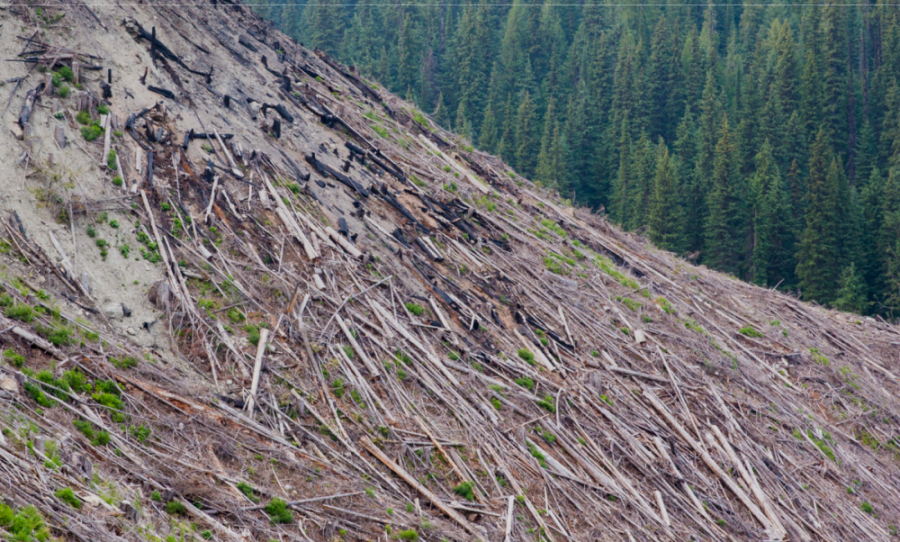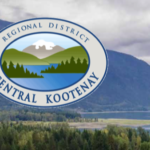$50,000 to save forest above Cottonwood Lake may be too little, too late
Caught off guard by a plan to log more than 600 hectares of treasured local forest, residents near Cottonwood Lake discovered that privately owned lands can be clearcut without public notice, consultation with neighbours or the requirement to replant logged areas
By Judith Lavoie, for The Narwhal
Against a dramatic backdrop of steeply forested slopes, Cottonwood Lake near Nelson draws thousands of summer visitors for swimming, picnics, lolling around on floaties or kayaks and fishing from the dock, while in winter the shallow lake is used for hockey games, community get-togethers and ice-fishing.
“Last year it was almost like a Norman Rockwell painting out there. It’s a really special little place,” said Andrew McBurney, spokesman for the Cottonwood Lake Preservation Society, a non-profit group formed in December to fight logging plans that residents believe threaten the widely used park and the nearby Apex Nordic ski trails.
Residents fear clearcut logging on adjacent privately owned land will destroy the scenic value of the small park and cross-country ski trails and, because of the steep terrain, could destroy unique wildlife habitat and cause landslides and flooding.
Local support for stopping the logging and expanding the park has been overwhelming. Within a month the Preservation Society exceeded its goal of raising $50,000 in seed money. Underlining the public support, a meeting, organized by the society, drew a standing-room only crowd of more than 400 people including wildlife, environmental, hydrology and tourism experts.
Below: an undated photo shows skating on Cottonwoood Lake

Hans Cunningham, a Regional District of Central Kootenay director, said residents and local politicians were horrified when they realized the land above the lake was about to be logged.
“We said whoa, that’s not nice. It’s not just the lake, it’s wetlands and grizzly habitat and ski trails. There’s a whole pile of environmental and recreational values,” Cunningham said.
“Directly above the lake it’s a very steep slope and, if it is logged, there’s probably a 75 per cent certainty that we are going to get either avalanches or landslides into the lake, which would negate it as a useful lake,” he said.
At the head of the lake — stocked with 2,000 trout each year by the Freshwater Fisheries Society of B.C. — are wetlands with a plethora of plant and animal species, which serve as the main migratory corridor for grizzly bears travelling between the South Selkirk and Bonnington Ranges.
“It’s a treasure…The lands that we want to save are not your average forested lots. They are the very essence of diversity,” McBurney said.
Leading grizzly bear researcher Michael Proctor, of the transborder Grizzly Bear Project and Kootenay Connect, said in a letter of support to the Preservation Society that he has personally put radio collars on eight grizzlies within the Cottonwood-Apex corridor.
The South Selkirk grizzly bear population is isolated and threatened, which makes the wildlife corridor particularly important, Proctor wrote.
“Our science reveals this area as locally and regionally important.”
Few rules for logging private lands
But options for stopping the work are limited as rules for logging on private land are almost non-existent and there is no necessity to file a logging plan, replant trees or consult neighbours.
That leaves large areas of the province open to strip-it-and-flip-it operators who cut the trees and then sell the denuded property to developers.
Cottonwood Lake illustrates what happens when there are few rules, according to the West Kootenay EcoSociety, which has organized a petition asking the province to regulate logging on private land and require land owners to publicise clear, advance logging plans.
“This clearcut logging is an awful scar on our local environment, but it’s symptomatic of a much bigger problem. A loophole in provincial regulation means that even basic rules meant to help safeguard natural areas don’t apply, because the land is privately owned,” says the petition.
Last year, the Union of B.C. Municipalities endorsed two resolutions, one of which was from the Regional District of Central Kootenay, asking the province to regulate logging on private land, and a Forests, Lands and Natural Resource Operations ministry spokeswoman said that, this spring, the ministry will be reviewing the private managed forest land regulatory framework.
On private managed forest land the Private Managed Forest Land Act applies and the Managed Forest Council investigates complaints, but the review is unlikely to cover logging practices on fee simple, privately-owned land where the rules are restricted to not violating provincial and federal legislation.
Anyone logging on privately-owned land is required to follow timber marking requirements and meet the provisions under the Wildfire Act, the Water Sustainability Act, the Drinking Water Protection Act, the Heritage Conservation Act, the federal Species at Risk Act and the federal Fisheries Act, said a ministry spokeswoman.
Meanwhile, the Regional District of Central Kootenay is negotiating to buy the slope above Cottonwood Lake, but all meetings are being held in camera, meaning details remain secret.
“The area hasn’t been specified or defined, but the lands being considered are adjacent to Cottonwood Lake,” confirmed Cary Gaynor, regional parks manager.
The problem is coming up with the funding and a combination of taxation, donations and grants is being considered, Gaynor said.
Although the entire area is worthy of protection, financially, the regional district can only consider buying the area above the lake, Cunningham said.
“Our financial resources are extremely limited because we are dependent on taxation, so it would be really nice if the province stepped in and bought the whole thing,” he said.
‘Let’s cut a deal’
An additional concern for those trying to save the area from logging is the history of the landowner — which, for many, flips the conversation back to the lack of logging regulations on private land.
The three parcels of land adjacent to the park and cross-country ski trails were bought in December 2017 by the Nelson Land Corporation, a company headed by Mike Jenks, who has been embroiled in logging disputes around B.C. for more than two decades.
Jenks, who specializes in buying private land, cutting the timber and then selling the cleared land, hit the headlines in the late 1990s when he bought 680 hectares of private land on Gabriola Island and one-third of Denman Island and, despite community outrage, immediately logged it. Other disputes involving his companies have erupted in the Okanagan and East Kootenays.
“He is known for how efficiently he can cut and remove trees,” Cunningham said.
The three parcels, which add up to 645 hectares, were sold to the Nelson Land Corporation for between $4 million and $5 million, but Jenks wants the regional district to consider the value of the timber as well as the price paid for the land and he is impatient with what he sees as unnecessary delays.
Below: the orange-shaded blocks are parcels owned by Nelson Land Corporation. Map courtesy Cottonwood Lake Preservation Society

There is huge support for protecting the lake and politicians are ignoring the wishes of their constituents, Jenks charged.
“It’s a great little lake and it should be protected…I went to the regional district and said, let’s cut a deal and preserve it for ever and ever and ever and the politicians just don’t want to cooperate. It’s not my fault. This should be up to government to protect it, not a private person. I need a return on my investment. It’s my livelihood,” he told The Narwhal.
Gaynor said there have been no deliberate delays and local politicians are doing their best to find a way to maintain the aesthetic and recreational values of the area, even though they do not yet have details of the logging plans or a firm price.
“We really just went into this with the idea of good faith bargaining,” Gaynor said.
Province-wide rules needed to save important areas
Jenks, who does not usually speak to media, is indignant about criticism of his logging practices and insists he is not clearcutting.
“It’s an emotional argument they use, not based in science. It’s just trees growing back. When you plant your garden and have your peas and potatoes and carrots and if you don’t harvest them when they are ripe, they just die and it’s the same with the forest. It’s just a crop that, if it’s looked after and replanted, will just grow again and again and again,” he said.
An example of his work can be seen on a 16-hectare patch he logged on one of the three parcels, he said.
The work stopped once negotiations started with the regional district.
“You should go look at what we have logged above Nelson. We have left strips along the creeks, we left buffer zones along the highways for visual things and we don’t get any credit for doing any of that. You just hear these horrible stories about how we have desecrated it and the planet is going to die because of what we have done,” Jenks said.
Cunningham has a different view of how Nelson Land Company has treated the 16 hectares, which are clearly visible as people drive into the community from the south.
“The method he uses is clearcut logging. The hillside looks like there is nothing there except for brown dirt and, for a community like Nelson that prides itself on being so green, it’s a bit of a shock when all you see is barren, brown hillside,” he said.
Hillside logging means mud is already being washed into Cottonwood Creek, Cunningham said.
“We are going to see some damage, no matter what,” he said.
Jenks, however, said he follows or exceeds all the rules for logging on private land.
“We log our private land to the same standards or better standards than licensees on Crown land,” he said, adding that the land he logged on Gabriola 20 years ago has now turned into a young forest with a park like setting.
Artist Paul Grignon, an acquaintance of Jenks’ and long-time Gabriola resident, was involved in the original Gabriola logging controversy and said in an e-mail to The Narwhal that “forests that were logged 20 years ago are coming back.”
The land is protected from being logged again because it is now in public hands, he said.
“The fact that these very nearly clearcut lands are now parkland is thanks to the community making a pro-active amenity zoning deal that put the land into public ownership at the expense of more residential lots being created,” Grignon said.
Among the lessons learned, that can apply to all communities dealing with logging disputes, is that, until rules are changed province-wide, residents or local governments have to be ready to pay to save important areas, said Grignon.
“You can either cut down the trees and buy the land with the money or you buy the land and trees with money you get elsewhere,” he said.
For members of the Cottonwood Lake Preservation Society, it is now a waiting game to see what can be negotiated.
Cunningham believes that the wait will not be long and, one way or another, negotiations with Jenks will wrap up within a month.


























Comments